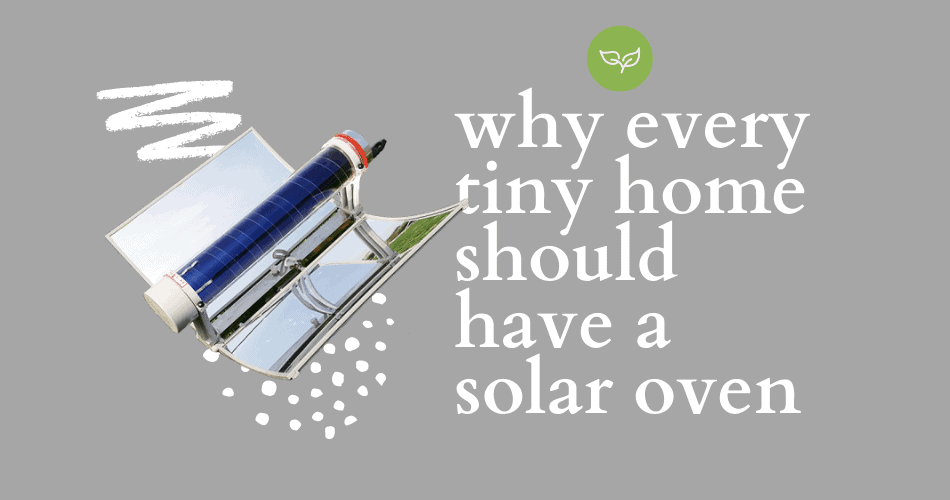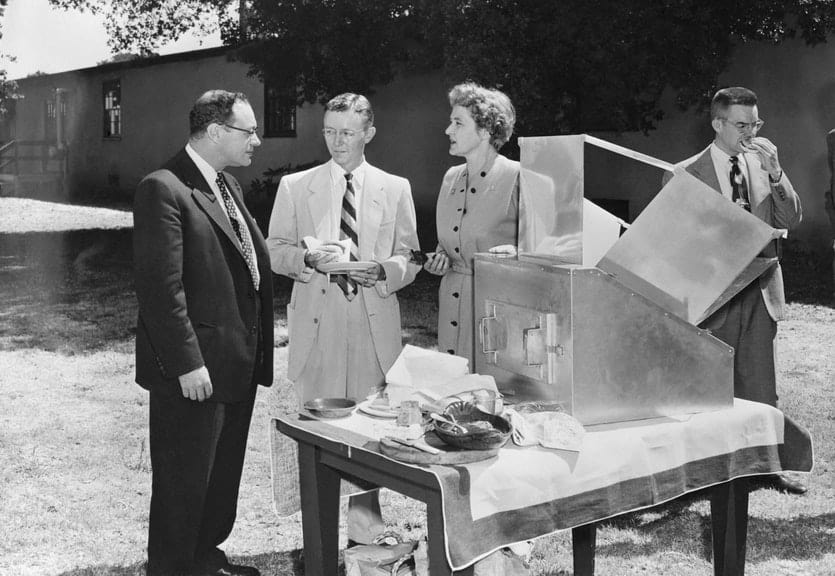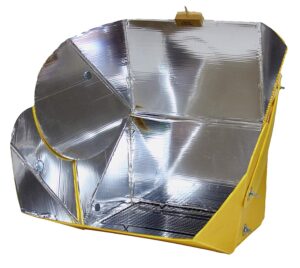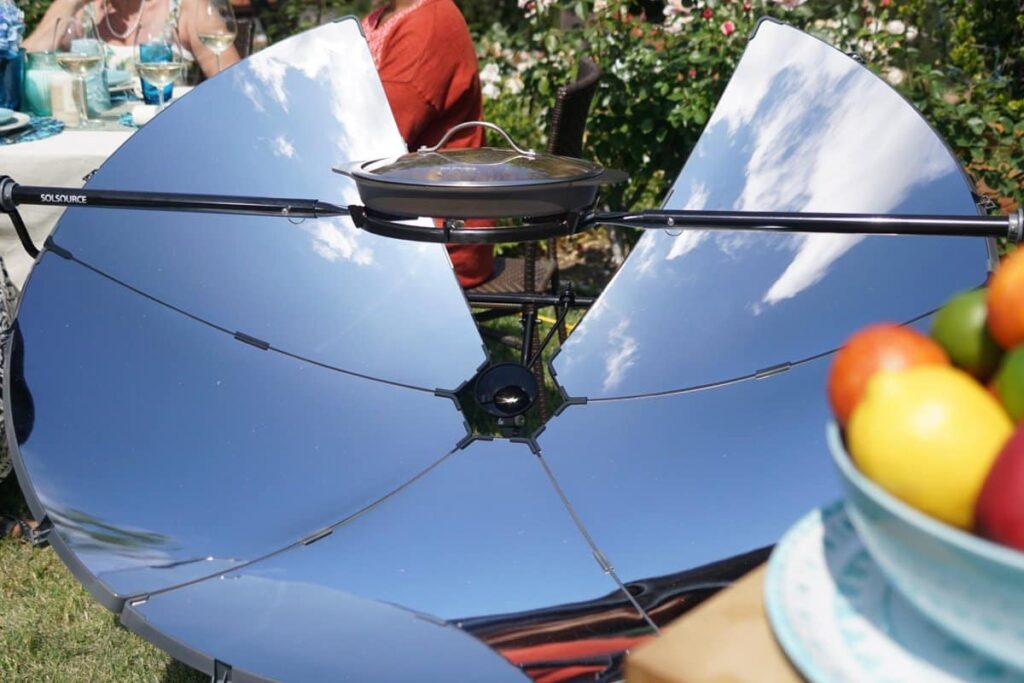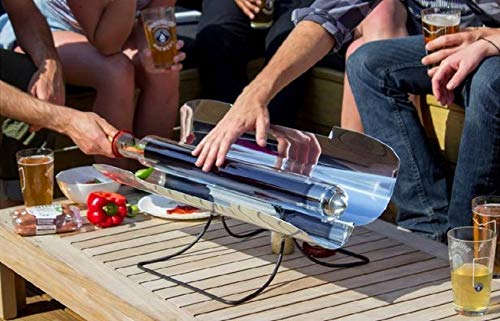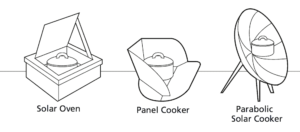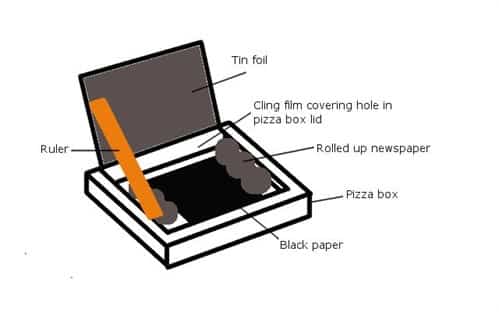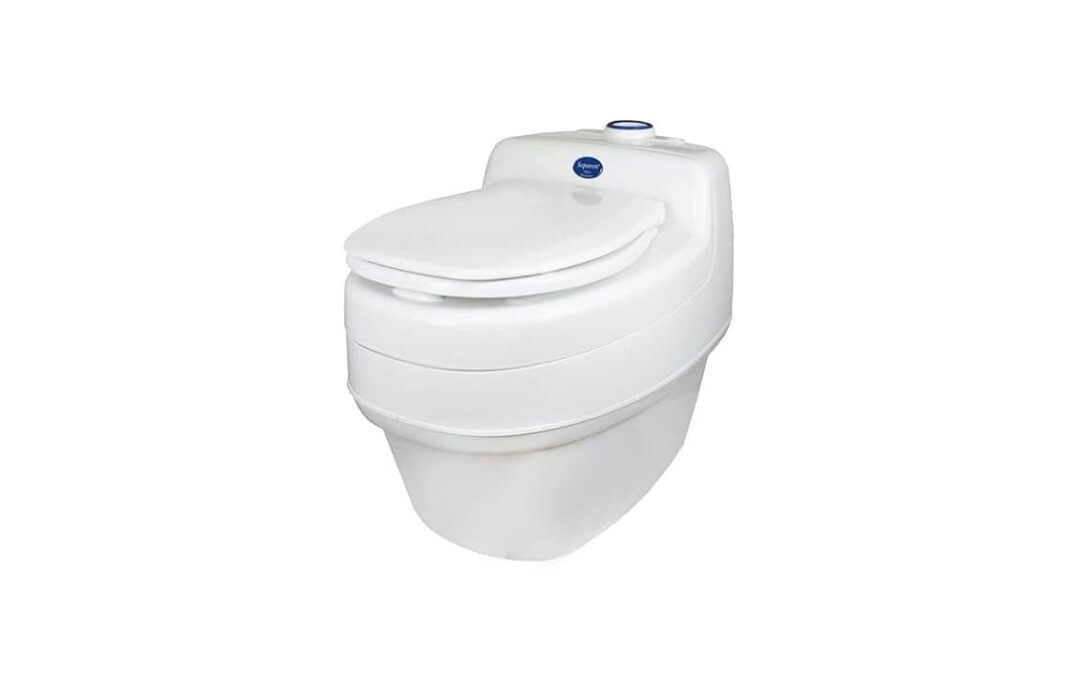When it comes to sustainable, efficient, and just flat out “cool” ways to cook, solar ovens are at the top of the list.
What makes solar ovens so awesome, is that they are able to efficiently and effectively cook food using nothing but the sun.
In this article, we will go into detail about solar ovens, how to use them, what to look for when buying and other helpful tips.
What Is a Solar Oven?
Solar ovens use reflective panels to capture and direct the sun’s rays directly onto the cooking area.
Simply stated, they allow you to turned the sun’s rays into delicious, mouth-watering meals.
There are several different designs for these stoves, from simple to elaborate, but regardless of the solar oven, they require no fuel other than sunlight.
Why is this important?
Because if you are living off the grid where power is limited, or you simply want to reduce your footprint on the planet, what better way than to use renewable solar energy.
Additionally, solar ovens are set up outdoors – which creates zero heat inside your home – a definite plus for keeping your home cool, especially in the summer months.
If you are using solar panels to supply a bit of power to run a 12-volt air conditioner, you want to run it as little as possible, so keeping excess cooking heat outside is the best strategy.
Surprising solar oven facts
Solar ovens are based on very old technology, and in 1767, Swiss physicist Horace de Saussure invented the first solar oven.

Today, the solar oven oven has come a very long way and serves an important purpose to a lot of people around the world, people that would otherwise have no means to cook.
Three countries – China, Darfur, and India – use solar ovens most predominantly.
Currently, hundreds of thousands of solar ovens are being used in refugee camps in Darfur to provide people with a means of cooking.
What Are the Best Solar Ovens In Use Today?
Box Solar Ovens
This is the most common oven used all around the world because it is inexpensive, simple to use, and easy to set up.

These are easily shipped, and are a great choice for those living remotely.
Box solar ovens, in many ways, are similar to slow cookers, and are perfect for slow roasts, stews, and other similar meals.
Folding out with anodized (typically) aluminum reflectors, they are designed to direct the sun’s rays toward the meal being cooked.
They are lightweight, yet suitable for preparing large meals, and can reach temperatures of 360 to 400-degrees F.
You can easily bake a pie or fry cook in these ovens. I’ve cooked some delicious pumpkin and cherry pies with my box solar oven, and it did not disappoint.
Now think of how nice it will be to have that heat outside.
Parabolic Solar Ovens
These ovens are different in the way they are shaped and their effectiveness.
Their dish shape, which is reminiscent of an older satellite dish, focuses the rays of the sun for maximum heating. Unlike box solar ovens, these are not slow cookers.

Their angled walls focus the heat to the bottom of the oven where temperatures can reach upwards of 550-degrees Fahrenheit!
You can fry foods in this oven with ease, and can even make some popcorn.
There’s really nothing like eating delicious buttery popcorn with your kids on a starry night in the middle of Spring.
My favorite memories are of sitting outdoors with my father, eating popcorn we cooked up in our solar oven, as he pointed out the Big Dipper, the Milky Way, and Orion.
Evacuated Tube Solar Ovens
This one is perfect for all the Star Trek lovers out there. They remind me of something that should be in the engine room of the Starship Enterprise and look unlike anything you might imagine.

Cylinders 2 or 3 feet in length slide into the clear cylinder, called a vacuum tube, which is designed to magnify the heat of the sun’s rays.
To use the oven, you place the food you want to cook in the trays that slide into the cylinder.
Surprisingly, the tubes don’t get hot on the outside, only the inside, which makes them great for:
- Being kid-proof
- Being pet-proof
- Not burning yourself when you may forget that it’s not the best idea to, you know, touch a hot stove.
Do you remember using a magnifying lens and catching grass on fire with your elementary school science teacher?
Probably not…
But I remember this vividly. Our class gathered around as our teacher held a magnifying glass next to a blade of grass on the ground.
In just a few moments, smoke began to appear. To our amazement, the blade of grass ignited into a ball of fire.
That is exactly the premise with this oven. The heat is harnessed and focused to make it far more potent.
This cooker is capable of reaching temperatures up to 550-degrees Fahrenheit and is suitable for most meals.
However, due to the shape of the cylinder, there is a learning curve. For example, you may have to adjust the portions and size of cuts of meat.
Although I have yet to verify this myself, this new design is supposed to be better at retaining your food’s flavor and juices.
Being one of the newer solar ovens on the market, the Evacuated Tube Solar oven is comparable to the other solar ovens in both price and functionality.
Go Sun has made a small model that fits in a case and can be carried via a backpack. This may be the best solar oven for you, if you enjoy being on the move as much as you enjoy weekends in the great outdoors.
Solar Panel Ovens
Solar Panel Ovens combine the technology of the box ovens and the parabolic ovens.
Its panels are used to trap the light and then reflect it to the cooking food in a separate box, which is designed to retain the heat that is being directed at it.
These ovens are slow cookers, and best for meals that need to be roasted slowly, similar to a crockpot.
While they don’t cook fast, they are inexpensive and easy to find, sometimes in local shops and sporting goods stores.
These are considered more portable and are recommended as the best solar ovens for RVing or THOW lifestyles.
However, you could easily adapt it for some cooking applications at your foundation home.

Environmental Considerations
Solar ovens harness the heat of the sun. Once you purchase a solar oven, there is no additional expense.
Unlike other cooking methods that may require portable LP (liquid propane) gas or the need to build a fire, solar ovens are nearly foolproof.
In many cases, building a fire is not always safe, and during certain times of the year that are dry, it takes only one spark in the wind to start a serious fire.
On the contrary, solar ovens will not start a fire. They are fully self-contained and the rays of the sun are directed within.
Additionally, solar ovens do not off-gas. Unlike LP, which releases gases into the environment, solar ovens do no such thing.
Solar ovens allow you to keep your precious power usage to a bare minimum by using the sun’s energy to cook outside in an outdoor kitchen, just like your ancestors did!
Indoor cooking is relatively new to mankind if you look at our history. Our ancestors were intelligent enough to realize how to save resources, including cool air, and cooked exclusively outdoors.
In fact, a lot of the methods being utilized and ‘re-discovered’ by off-grid enthusiasts are things that used to be considered the norm, and is one of the reasons that people enjoy living off grid so much.
It’s a way of connecting to our past and understanding what living was like before cars, freeways, cell phones, and social media.
“Getting away from it all” can be made easier by using modern twists on old technology.
Pros and Cons of Solar Oven Cooking
Using solar ovens is a little different than what you are used to. With solar ovens, it isn’t as easy as turning on the gas oven and letting it pre-heat.
Once you get used to solar ovens, however, you’ll be able to plan meals and time your cooking with ease.
When you make your initial solar oven purchase, take into consideration what types of food you expect to be cooking.
Choosing The Right Sized Solar Oven
Solar ovens vary greatly in size, so it’s important you choose the right one for your needs.
Do you like fried foods? Big meals?
If you are going to want to cook things at higher temperatures, so that you can fry or prepare multiple dishes at once, you’ll want a bigger oven.
Conversely, if it’s just for yourself, and you don’t mind slow-cooking meals, a smaller oven will be fine for you.
Solar Oven Maintenance
Another thing that’s great about solar ovens is they can easily be cleaned. Because they have no working parts, there is little to ever go wrong with them.
The result…
A solar oven that will last for years with little to no maintenance.
DIY: Making Your Own Solar Oven
Now that we’ve considered the many types of ovens on the market and discussed their applications, let’s talk about how we make our own.

One of the things that most people who live off grid have in common is that they enjoy the challenge of being more self sufficient than the average person.
Perhaps you are considering living off the grid because you care about the environment and, although the best solar ovens available for sale are great, you enjoy upcycling.
I’m going to tell you a little secret: you can make your own solar oven and it isn’t difficult.
Whether you consider it as a family fun project on a weekend, or you consider making your own oven so that you can recycle some cardboard, making a solar oven is definitely doable.
You’ll need a few things to get started
- A cardboard box that is at least 18 inches wide and 22 inches long. You’ll want it as deep as your cookware is, so consider your pot depth.
- A second box that can be used to construct your ‘parabolic dish’ around the stationary box that will hold your food.
- A large roll of aluminum foil
- Some black paint for making the inside of the cooking box black to absorb heat reflected at it.
Watch this short video to learn how to build your own:
This box oven will get very warm, but it is not really suitable for cooking on a grand scale. It will reach temperatures of 160-200 degrees Fahrenheit, typically.
You can still d some pretty cool things with it, though, like make s’mores with your kids or friends as a part of a weekend project.
For more realistic DIY cooking applications (which we will go in more detail in a future article) you can create far more elaborate boxes by using old window panes on boxes constructed of wood.
Find old recycled mirrors to redirect your sunlight and get creative. Use dark paint on the inside bottom of your cooking surface.
Rummaging through thrift stores can be fun. You might be surprised at some of the great ideas you can come up from just walking around these stores.
You can also use new lumber and build your solar oven from scratch if you prefer. It only takes a few nails and some wood.
Then you need anything that can be used as a reflective surface to direct light into your box. Try a car shade screen made with reflective foil. They’re easy to wrap and hold into place.
Pop in a thermometer so you know how hot your food is getting and you’re in business.
It’s a project that takes around an hour or two from start to finish.
Remember to attach a thermometer to the inside of your oven so that you can see how hot it is getting.
Sometimes the real fun in living off grid, whether full-time or as a weekend warrior, is having fun with projects that remind you how enjoyable simple things can truly be.
When you sit down to a meal that was cooked in your own homemade solar oven, it will taste so much better.
If your kids help with the project, you can make s’mores with them, pop popcorn or bake a cake.
Challenging your children to take part in the process leads to them enjoying the satisfaction of actually using the project when completed.
It’s also a fantastic way to teach them how to problem solve, build things, and develop into self-sufficient adults one day.
These family fun projects help them learn and enjoy being a part of the off-grid lifestyle. Your teaching a new generation how to be self-sufficient and respect the environment.
You’re also making memories that they will carry through life and pass on to their own children someday.
Whether You Purchase Your Oven or Build One
Solar ovens are simple tools that provide a huge benefit. They will work in winter and in summer as long as you have access to bright sunlight.
Exceedingly cold temperatures will lower the peak temperature of your oven, but insulation in the walls will help trap heat.
They are great for the environment, and they don’t have to be watched closely. And since there is no fuel involved, they are extremely safe.
These handy tools allow you to place your food inside and then go do anything else that you’d like.
You’re helping the environment and using the things that nature has given to us for survival. It’s a return to the old ways. It benefits you now and future generations later on.
Using a solar oven is a little addictive. Once you use it, you’ll go a bit crazy trying new things in your oven. It’s fine …
You are not wasting anything. Go for it.
Further reading suggestion: Intrigued by solar gadgets now? Check out our article on the top 10 solar gadgets of 2019

